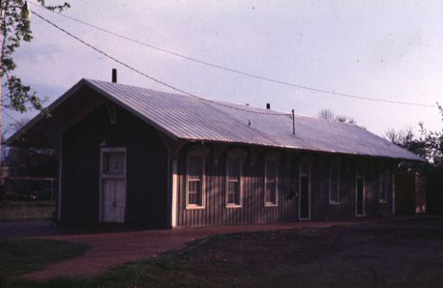Railroad Depot(now Head Start) Depot Park, 1866 |

Over long decades the iron horse was a central fact about America, impressing its rhythms, sights, and sounds on daily life in elemental ways now all but forgotten -- the warning whistle's wail, the measured thunder of approach, the stranger's face at the spattered window. Trains compressed distance, broke down community isolation, and imposed a semi-public style on the experience of travel. The depot, main portal to the town for students, parents, businessmen, and travellers of all kinds, was a meeting place alive with expectation, connecting the village with the world.
Oberlin's first rail line came through in 1852. The new depot went up a year after the Civil War, when direct service opened to Elyria, cutting travel time to the county seat from two hours to 20 minutes. The depot's completion was a moment of some pride in the village. "We may reasonably expect," the local paper declared, "that our depot will contribute greatly to the removal of any wrong opinion as to the beauty of the town." A well-proportioned building with broad eaves to protect passengers from the weather, the depot housed telegraph, ticket, and baggage offices as well as separate gaslit waiting rooms for gentlemen and ladies. The exterior board-and-batten walls were painted stone gray with dark gray trim. In the spring of 1867 station agent Lester Kinney set out 125 shade trees and 25 evergreens in the surrounding park with its curving gravel carriage drive. The great age of steam transportations was underway, with half a dozen daily trains connecting Oberlin east and west.
Then the automobile came along. The railroad era ended in 1949 when Oberlin's last passenger train, nicknamed the Plug by villagers who used its 6:20 a.m. whistle for an alarm clock, made its final run by order of the Ohio Public Utilities Commission. Twenty years later the Nordson Foundation renovated the depot for use as a Headstart school. Its exterior has been faithfully preserved.
The depot is on the National Register.
(Blodgett 96-97)